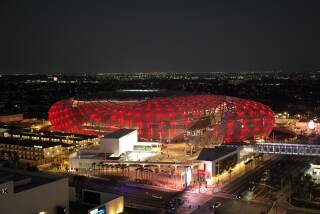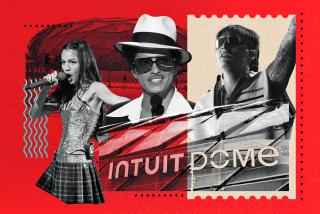Sound of Infinity, Zen of Sell : $45,000 Loudspeakers for the Few Help Pitch Less Costly Ones to the Many
- Share via
Cary Christie, executive vice president of Infinity Systems in Chatsworth, leads the way to the Mt. Everest of loudspeakers. In the back of his factory, towering above him, rest 7 1/2-foot-tall loudspeakers, each encased in hand-crafted Brazilian rosewood.
This mountain of sound, four columns in all, weighing 1,550 pounds, comprise a set of speakers called the IRS V. These are not speakers that the Grateful Dead haul around for concerts; instead they are designed to be state-of-the-art speakers for the living room. And they can be yours for $45,000 a set, retail.
“It’s our ultimate R&D; toy,” Christie said. “It also provides us with a lot of free advertising.”
Not that Infinity makes a living selling $45,000 speakers. In fact, the company sells only about 15 sets a year--although there is a six-month backlog. But that ultra high-tech image, Christie said, along with some of the exotic technology, help sell the rest of Infinity’s wide product line, down to its $160-a-pair speakers.
You Could Buy a Mercedes
Granted, with inflation, $45,000 does not buy what it once did. But you can still buy a new Mercedes-Benz or 40 acres of land in Minnesota for that sum. Are these $45,000 loudspeakers 10 times better than a rival $4,500 system? “It’s 1,000 times better,” blurted out Arnold Nudell, the company’s president and co-founder.
Christie, more restrained, said, “No. It’s a small percentage better.” He added, “Is a Ferrari for $100,000, is it 10 times as good as a Volkswagen? That’s a tough call. It depends on what your criteria are.”
One rival audio executive, who has no great affinity for Infinity, says the $45,000 speakers “are much ado about nothing. But about half the audio business is perception. If the perception is good, you can get away with it.”
Welcome to the crowded loudspeaker industry, with at least 250 brands seeking the customer’s ear. It is a very competitive business, but for those companies who can set their products apart as something special, profits can run as high as 10 cents per dollar of sales.
Infinity, founded 20 years ago by Nudell and Christie in a garage, is now owned by Harman International, a publicly held audio conglomerate with 1987 sales of $328 million, based in Washington. Harman also owns the JBL, EPI and Concord loudspeaker lines, as well as Harman-Kardon, a maker of receivers and CD players.
Although Harman does not break out sales for its divisions, analysts rank Infinity as one of the three or four biggest loudspeaker firms in the United States, along with JBL, Bose and Polk Audio.
Nudell says two-thirds of Infinity’s sales are from speakers that cost at least $800 a set. The recent popularity of the compact disc player, with its precise sound, has spurred sales of higher-quality speakers. But Infinity has also moved into other areas. It has a deal with Chrysler to design speakers for its cars. And last year Infinity introduced a $5,000 big-screen TV.
It all adds up, Nudell suggests, to about $60 million a year in sales.
“I wouldn’t believe it,” said George Klopfer, president of Polk Audio in Baltimore. He pegs Infinity’s sales closer to $30 million.
Nudell, now 50, is mercurial, intense, temperamental, and a skillful promoter, his peers say.
Andy Petite, chief designer for Boston Acoustics, a Peabody, Mass., loudspeaker company, concedes that Infinity “makes good speakers.” But he suggests that Infinity’s customers cannot always hear the difference in technology that the company so loudly touts.
Other Than Sound
Customers who spend more than $800 a pair for loudspeakers, Petite said, “do so for other reasons than sound quality. Other factors are the furniture aspect, the perceived technology, sometimes the arcaneness, of installing the systems,” he said. “Infinity has been extremely good at catering to that kind of buyer.”
Petite, for one, is not sold on the sound of Infinity’s expensive models. “Their lower-priced speakers sound less tricked up and more musical to me than the high-priced ones,” he said. “I don’t believe Arnie actually believes they are doing things in a tricky way, or to hoke the sound up. They are searching for nirvana.”
More than anything else, Infinity’s reputation today stems from its $45,000 behemoth loudspeakers.
Loudspeakers work by passing an electric current through various diaphragms, which in turn moves enough air to create sounds. Nudell and Christie talk of wave-propagation formulas, harmonic-structural integrity, energy response and rise time. But this is audiophile talk. The goal is to recreate what a live concert actually sounded like to someone sitting in the sixth row, center.
Certainly, the menu of components in Infinity’s $45,000 system is elaborate. There are 108 different speakers in all, front and back. Some of the tweeters (for higher sounds) move thousands of times a second, are made of aluminum one-third the thickness of a human hair, and are controlled by rare earth neodymium magnets. The cabinets, finished by a shipbuilder, cost $8,000, and the two curved speaker columns are filled with sand, between the layers of wood, to dampen sound vibrations.
But is the sound good?
Audio magazine recently ran a feature headlined “A Search for the Ultimate Loudspeaker.” The story abundantly praised the big Infinity system as “the speaker which defines the limit of what any design team can accomplish” and “the only speaker I have heard which allows you to approach the illusion of sitting in a cathedral and hearing music played in that kind of space.”
‘Very Nice’
Klopfer has given it a listen as well. “It’s very nice. And for $50,000, it ought to be. I don’t know if it’s the best in the world. It’s a very good sound system, and gratuitously priced.”
Mike Kay, who runs Lyric Hi-Fi in New York, sells more of the big IRS speakers than any other dealer. “It’s not an item any salesman is capable of selling. You want it, and you decide to buy it.” Kay sold a set to Roy Halee, producer and engineer for singer Paul Simon. Simon bought a smaller Infinity system a few years ago, Kay said.
Kay tries to dissuade customers from buying the system if they don’t have enough space; ideally, a 500-square-foot room with 10-foot ceilings. “If you hire an orchestra, you better have space to put them, or it makes no sense,” he said.
But ordering the speakers is just the start. Another $45,000 or so is necessary, Kay says, for a first-rate preamplifier, amplifier, CD player, tuner, fancy speaker wire, record player, etc.
Kay charges about $5,000 to install the four speakers, which also covers the first year’s warranty of parts, labor and jet fare. Jet fare? If there’s a problem, the stereo doctor has to make a house call. “Who’s going to move it, a 1,500-pound speaker?” Kay asked. Recently Kay dispatched two of his engineers to a Florida customer for two days to tinker with a new set of big Infinity speakers after a capacitor blew out.
As expensive as they are, Infinity’s speakers are not the most expensive on the market.
Wilson Audio Specialties, a Novato, Calif., company, sells a speaker system called the Wilson Audio Modular Monitor, or Wamm, for $80,000 in the United States; $85,000 overseas. The price includes an appearance by inventor David Wilson, who has flown to homes in Geneva and Macao, he says, to do the installation. Wilson sells only a few sets a year.
The big Infinity speakers, Wilson said, “are among the best.” But he prefers his own, maintaining that Infinity’s big speakers suffer from a sluggish, heavy, bass sound. Christie counters that Wilson’s speakers are “an assemblage of other components” he doesn’t make.
Infinity got its start in the late 1960s in Nudell’s Woodland Hills garage. A self-described “music fanatic” on the classical music and opera side, Nudell was building his own loudspeakers in high school. He earned a master’s degree in nuclear physics from UCLA, then spent six years in aerospace, including a stint at Litton, where he worked in their laser labs. Working on military contracts, he found, was sterile and repressive, and he had a run-in with his boss, who told Nudell to take down a picture of Albert Einstein in his office.
Meeting of Tinkerers
Nudell then met Christie, now 43, another stereo tinkerer who studied engineering at UCLA. Along with a third friend--who later dropped out--they got together on weekends in Nudell’s garage and, after $5,000 worth of parts and 18 months, came up with what Nudell said was a breakthrough loudspeaker that eliminated the fuzziness of bass sounds.
In 1968, they got some financial backing from investors, and Nudell drove up and down the East Coast in a station wagon, setting up the $2,000 speakers in dealers’ showrooms. And after a glowing review in High Fidelity magazine, the company’s reputation was made.
In 1974, Electro Audio Dynamics, which owned KLH, a pioneer stereo brand, bought Infinity and provided it with enough capital to keep growing. In 1981, Infinity was almost sold to Kyocera, a Japanese firm, as part of a package deal, but Nudell and Christie threated to walk out rather than be part of a distant conglomerate. Instead, as Nudell hoped, EDA sold Infinity to Harman.
These days Nudell has a set of the $45,000 Infinity loudspeakers in his Bell Canyon home. But the big speakers, he claims, are now technologically ahead of CD recordings, to the point where the flaws in the recording are exposed.
So does it ever sound like a concert hall at home? “There are a few times when it’s really capable of fooling me,” Nudell said. “Unfortunately those seconds are really fleeting.”
More to Read
Inside the business of entertainment
The Wide Shot brings you news, analysis and insights on everything from streaming wars to production — and what it all means for the future.
You may occasionally receive promotional content from the Los Angeles Times.











